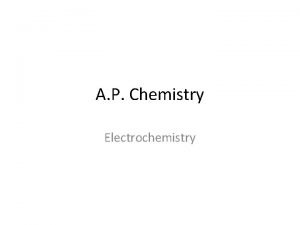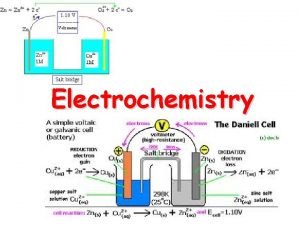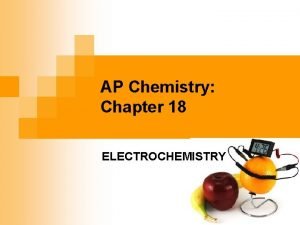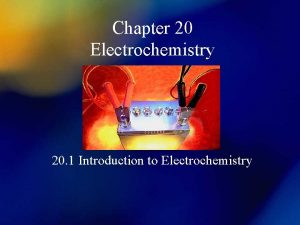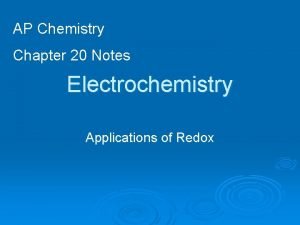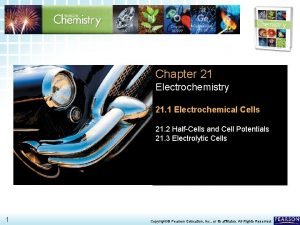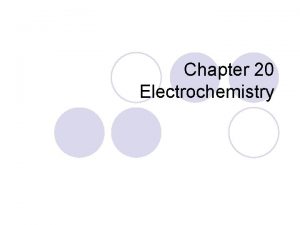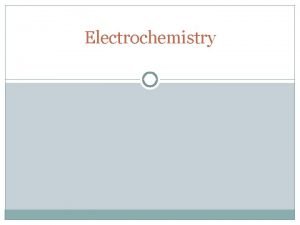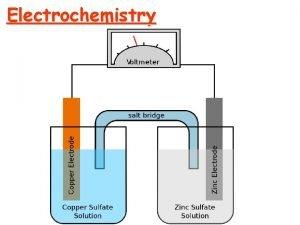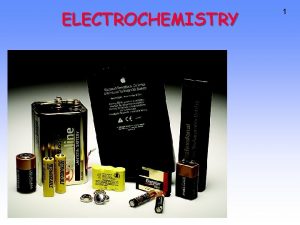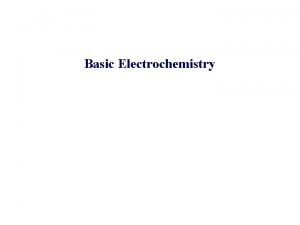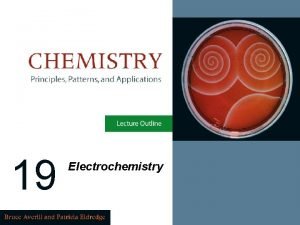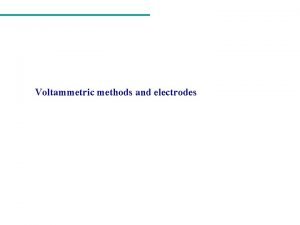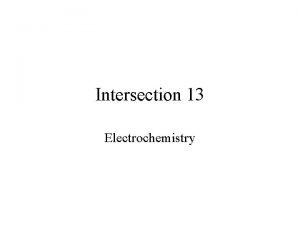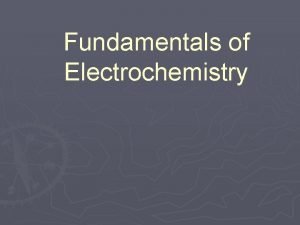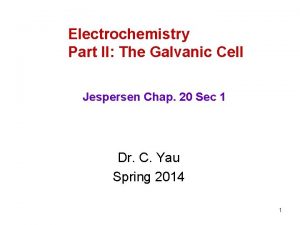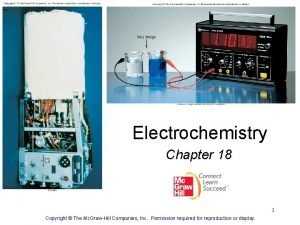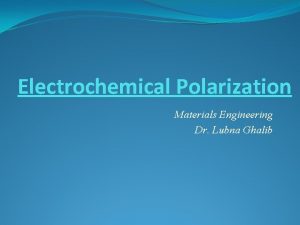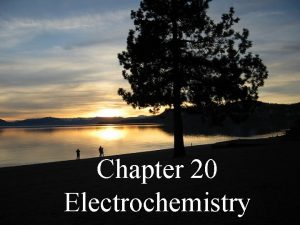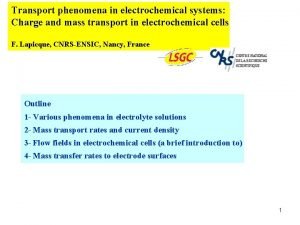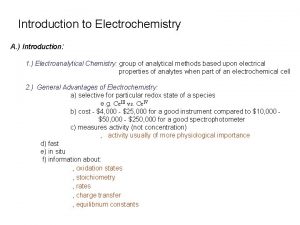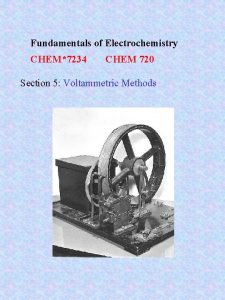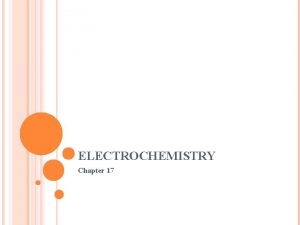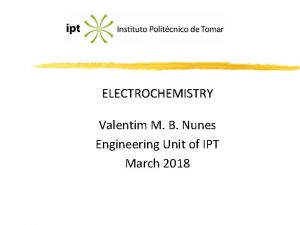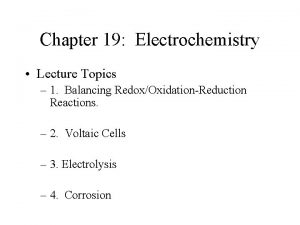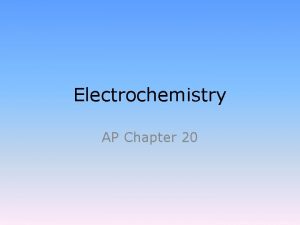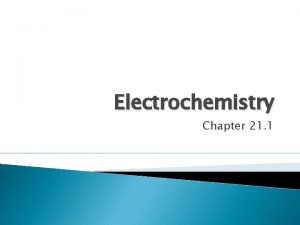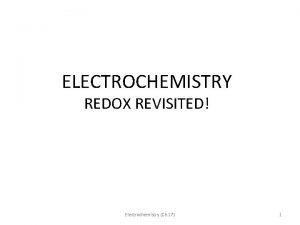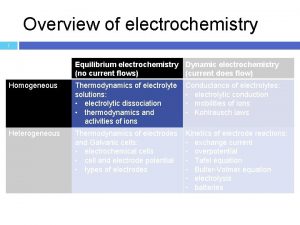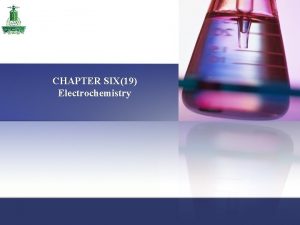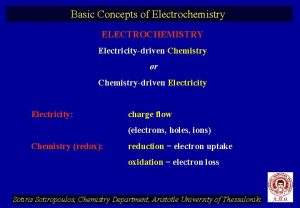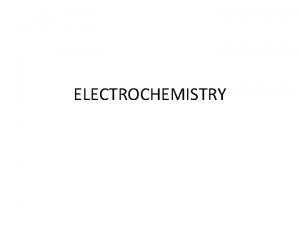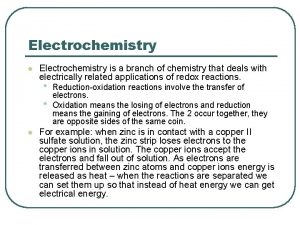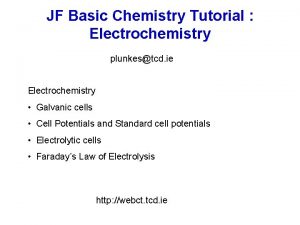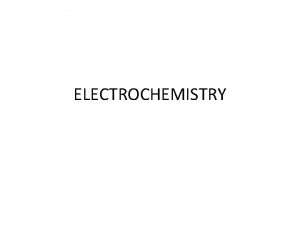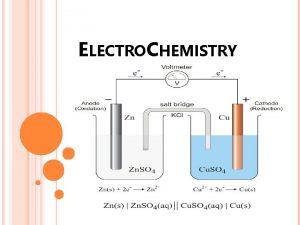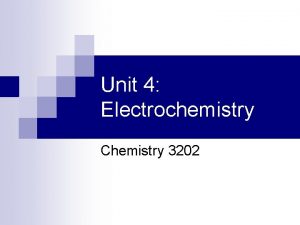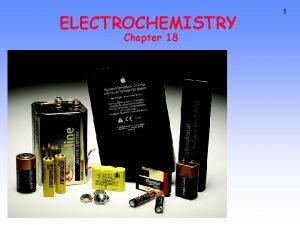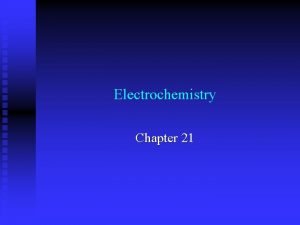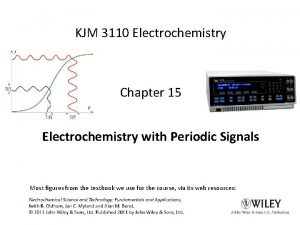AP Chemistry Chapter 18 ELECTROCHEMISTRY Electrochemistry in our




















































- Slides: 52

AP Chemistry: Chapter 18 ELECTROCHEMISTRY

Electrochemistry in our Lives n Whether we are referring to cell phones, calculators or cars, many things in our lives run off of batteries, so understanding the chemical reactions involved is important for all chemists. Electrochemistry is defined as the study of the interchange of chemical end electrical energy and involves the generation and use of electrical currents.

18. 1 Balancing Oxidation. Reduction Equations: A review Electrochemistry involves the generation of an electric current due to an exchange of electrons between two substances. n Oxidation-reduction reaction (redox)- involves the transfer of one of more electrons from one atom to another. n ¨ Oxidation can not occur without reduction!

As one substance loses electrons, the other gains them. Both become more stable by this process.

Oxidation Reduction Loss of electrons Gain of electrons Increase in oxidation # Decrease in oxidation number Memory Tricks: OIL RIG (oxidation is loss of electrons, reduction is gain of electrons) or Leo the Lion Goes Ger! (lose electrons = oxidation, gain electrons = reduction) Reducing Agent- Substance which is oxidized and causes another substance to be reduced. Oxidizing Agent- Substance which is reduced and causes another substance to be oxidized.

Half Reactions n Half-reaction- Equation written to show either the loss or the gain of electrons (shows number of electrons transferred) Ex. Ox. Fe+2 Fe+3 + e Red. Cu+2 + 2 e- Cu

Balancing Oxidation-Reduction Equations: A Review n When balancing these reactions, use the half-reaction method that we practiced earlier in the year. Common oxidizing agents Mn. O 4 - in acidic solution Mn. O 2 in acidic solution Products formed Mn 2+ Common reducing agents Products formed halide ions free halogen free metals metal ions Mn. O 4 - in neutral or basic solution Mn. O 2(s) sulfite ions or SO 2 sulfate ions Cr 2 O 72 - in acidic solution Cr 3+ nitrite ions nitrate ions HNO 3, concentrated NO 2 free halogens, dilute basic solution hypohalite ions HNO 3, dilute NO free halogens, conc. basic solution halate ions H 2 SO 4, hot, concentrated SO 2 metal-ous ions metal-ic ions Na 2 O 2 Na. OH H 2 O 2 HCl. O 4 Cl- C 2 O 4 2 - CO 2 H 2 O metal-ic ions metal-ous ions free halogens halide ions

Practice: n Potassium dichromate solution is added to an acidified solution of sodium sulfite. Cr 2 O 72 - Cr 3+ SO 32 - SO 42 Cr 2 O 72 - +3 SO 32 - + 8 H+ 2 Cr 3+ +3 SO 42 - +4 H 2 O

Now You Try It! Potassium permanganate is titrated with hydrobromic acid in a redox titration. - Mn 2+ Mn. O 4 Br Br 2 2 Mn. O 4 - + 10 Br - + 16 H+ 8 H 2 O + 2 Mn 2+ + 5 Br 2

Now You Try It! A concentrated solution of sulfuric acid reacts with nickel. H 2 SO 4 SO 2 2+ Ni H 2 SO 4 + Ni + 2 H+ SO 2 + 2 H 2 O + Ni 2+


18. 2 Galvanic Cells n n n There are two types of chemical cells. Galvanic cell- chemical cell in which chemical energy is changed into electrical energy Also called a voltaic cell These reactions are spontaneous Electrolytic cell- chemical cell in which electrical energy is changed into chemical energy These reactions are nonspontaneous

In a galvanic or voltaic cell, the transfer of electrons can be used as an energy source if it is harnessed. One way that this may be done is by separating the two halfreactions and requiring the electron transfer to occur through a wire. n The electron flow (electricity) can be used to Galvanic Cells do useful work. n

Keeping Cell Charge Neutral n The solutions must also be connected in another way or the charge will become unbalanced and the electrical flow will stop. This connection is often by a salt bridge (tube filled with conducting solution) or porous disk. Ions flow from one compartment to the other to keep the net charge zero.

The Anode and Cathode n n Anode- The electrode at which oxidation occurs. After a period of time, the anode may appear to become smaller as it falls into solution. Cathode- Electrode at which reduction occurs. After a period of time, it may appear larger, due to ions from solution plating out on it

n Let’s See a Video

Memory Tricks! n n n An Ox and Red Cat Oxidation occurs at the anode Reduction occurs at the cathode. FAT CAT Electrons travel from the anode to the cathode From the reducing agent to the oxidizing agent in a galvanic cell.

Animation

Cell potential (Ecell) or electromotive force (emf): n A galvanic cell consists of an oxidizing agent in one compartment that pulls electrons through a wire from a reducing agent in the other compartment. This “pull” is the emf or cell potential of the battery and is the driving force of the reaction. ¨ It is measured in volts: (1 joule of work per coulomb of charge transferred) 1 V = 1 J/1 C ¨ Cells with positive Ecell values are always spontaneous.

Cell Potential E ocell = E oox + E ored (Standard cell potential is the sum of the standard oxidation potential for the oxidation half-reaction and the standard reduction potential for the reduction half-reaction. ) n E cell = E ox + E red when the reaction is carried out under non-standard conditions n Standard conditions are 1 atm, 25 o. C, and 1 M solutions n

Cell Potential in the Real World n Note: The cell potential that you measure in an experiment will often be lower than what you expect. In the real world, the resistivity of the wire that carries the current can reduce the amount of electrons that “get through”, thus reducing the cell’s overall potential.

18. 3 Standard Reduction Potentials n n The values for E are usually written as reduction reactions (to change to oxidation, reverse reaction and change the sign of the potential) and can't be determined directly. These values are determined by the use of a standard hydrogen electrode which is arbitrarily assigned a value of 0. 00 All other half reactions are expressed in reference to the standard hydrogen electrode Standard hydrogen electrode- a platinum electrode in contact with 1 M H+ and bathed by hydrogen gas at 1 atm 2 H+ + 2 e- H 2 Eo = 0. 00 V

18. 3 Standard Reduction Potentials

Reduction Potentials n n n Elements with very negative values (metals) are easily oxidized (thus the negative value for gaining electrons) while elements with very positive values (nonmetals) are more easily reduced (have higher electronegativity and thus easily gain electrons). The more positive the reduction potential, the more likely to gain electrons and act as an oxidizing agent. Substances with negative reduction potentials (and thus positive oxidation potentials) are more easily oxidized and act as reducing agents. The more negative the reduction potential, the stronger the reducing agent.

Standard Reduction Potentials in Aqueous Solution at 25°C in a. Reaction G ( Half ! ced due u d e + 2 e- 2 Fily(g) ly r F Easi rons eas 2 t 3+ + e- Co 2+ elec to high. Co ity. ) v i t a 3+ neg Au + 3 e Au (s) o r t c ele Cl (g) + 2 e- 2 Cl- Eo (V) Half Reaction Eo (V) 2. 87 Ni 2+ + 2 e- Ni(s) -0. 25 1. 82 Co 2+ + 2 e- Co(s) -0. 28 1. 50 Tl+ + e- Tl(s) -0. 34 1. 36 Cd 2+ + 2 e- Cd(s) -0. 40 O 2(g) + 4 H+ + 4 e- 2 H 2 O(l) 1. 23 Cr 3+ + e- Cr 2+ -0. 41 Br 2(l) + 2 e- 2 Br- 1. 07 Fe 2+ + 2 e- Fe(s) -0. 44 2 Hg 2+ + 2 e- Hg 22+ 0. 92 Cr 3+ + 3 e- Cr(s) -0. 74 Hg 2+ + 2 e- Hg(l) 0. 85 Zn 2+ + 2 e- Zn(s) -0. 76 Ag+ + e- Ag(s) 0. 80 Mn 2+ + 2 e- Mn(s) -1. 18 Hg 22+ + 2 e- 2 Hg(l) 0. 79 Al 3+ + 3 e- Al(s) -1. 66 Fe 3+ + 3 e- Fe 2+ 0. 77 Be 2+ + 2 e- Be(s) -1. 70 I 2(s) + 2 e- 2 I- 0. 53 Mg 2+ + 2 e- Mg(s) -2. 37 Cu+ + e- Cu(s) 0. 52 Na+ + e- Na(s) -2. 71 Cu 2+ + 2 e- Cu(s) 0. 34 Ca 2+ + 2 e- Ca(s) -2. 87 Cu 2+ + e- Cu+ 0. 15 Sr 2+ + 2 e- Sr(s) Sn 4+ + 2 e- Sn 2+ 0. 15 Ba 2+ + 2 e- Ba(s) S(s) + 2 H+ + 2 e- H 2 S(g) 0. 14 Rb+ + e- Rb(s) 2 H+ + 2 e- H 2(g) 0. 00 K+ + e- K(s) Pb 2+ + 2 e- Pb(s) -0. 13 Cs+ + e- Cs(s) Sn 2+ + 2 e- Sn(s) -0. 14 Li+ + e- Li(s) 2 se o ! (L e to -2. 90 d ize ly du y. ) d i -2. 92 x asi tivit o y sil -2. 92 s e nega a n E tro c ec l ele -2. 92 e low -2. 89 -3. 05

Calculating Cell Potential n n When combining half reactions to obtain balanced redox reactions and calculating cell potential, you do not multiply the cell potential by an integer even if you multiply the halfreaction by an integer when writing the redox reaction. If Ecell is positive the reaction is spontaneous. If Ecell is negative the reaction is nonspontaneous. Electrons will flow in the direction that will make the Ecell positive.

Ex. A voltaic cell is made of chromium (III) and lead (II) metals in solutions of their own ions. Draw the cell below and label the anode, cathode and salt bridge. Indicate the direction of electron flow, calculate the cell potential and write the overall cell reaction. Indicate if this reaction is spontaneous or not. One reaction must be oxidation and the other must be reduction (we must reverse one). The sum of the two potentials must be positive. 2(Cr Cr 3+ + 3 e-) Eo = +0. 74 3(Pb 2+ + 2 e- Pb) Eo = -0. 13 2 Cr + 3 Pb 2+ 2 Cr 3+ + 3 Pb Eocell = 0. 61 V Reaction is Spontaneous!

Line Notation n A voltaic cell may be described in an abbreviated manner called line-notation. In this form the anode is on the left, followed by its aqueous solution. The right side consists of the aqueous solution for the cathode and finally the cathode. A single vertical line separates the electrodes from their solutions and a double vertical line between the anode solution and the cathode solution represents a salt bridge. ¨ Ex. Mg(s) | Mg 2+(aq) || Al 3+(aq) | Al(s) ¨ This cell has solid magnesium as the anode immersed in a solution of magnesium ions. The cathode is solid aluminum immersed in a solution of aluminum ions.

Ex. A galvanic cell is composed of solid zinc as the anode immersed in a solution of 1. 0 M zinc ions and a cathode which is an inert platinum electrode immersed in a 1. 0 M hydrogen ion solution with hydrogen gas bubbled in at 1 atm pressure. Write the line notation for this cell and the half reactions. Calculate the cell potential and indicate whether it is spontaneous or not. Ex. Zn | Zn 2+(1. 0 M) || H+(1. 0 M); H 2 (1 atm) | Pt anode (oxidation): Zn 2+ + 2 e- Eo = 0. 76 V cathode (reduction): 2 H+ + 2 e- H 2 Eo = 0. 00 V Ecell = 0. 76 + 0. 00 = 0. 76 V The reaction is spontaneous as written.

18. 4 Cell Potential, Electrical Work and Free Energy n n The greater the positive potential of a cell, the greater the spontaneity of the reaction. The difference in the potentials of the anode and cathode provide thermodynamic driving force of the reaction. This force can accomplish work.

Calculating Free Energy, G n Since G, K, and E 0 are all measurements of the spontaneity of a reaction, we can write equations to interrelate them. ¨ Emf (E ) = work (w)/charge (q) (measured in J/C) ¨ w = E q and q = n (# mol) x F (faraday = 96, 485 C/mol e -) n n If E 0 is positive, G is negative (spontaneous) and work is flowing out of the system into the surroundings Don’t forget, to find K: G = -RT ln. K G 0 = -n. F E 0 G 0 is the standard free energy change (units are J) n is the number of moles of electrons transferred F is a Faraday (see above) 96, 485 Coulombs/mol e. E 0 is standard cell potential (J/C or V) n n n

18. 5 Dependence of Cell Potential on Concentration All of the calculations of cell potential we have done thus far have been for cells at standard conditions, or 1 M solutions. n Ask yourself, based on the reaction below, what would happen to the cell potential if the concentration of the cerium IV ion was doubled? Why? n ¨ Cu(s) + 2 Ce 4+(aq) Cu 2+(aq) + 2 Ce 3+(aq) ___________________

The Nernst Equation n If cell concentrations are not standard (1 M) and 250 C, the cell potential is affected. This effect can be determined by using the Nernst equation. ¨ This equation is derived from the equation used for free energy when pressures were not all 1 atm : G= G 0 + RT ln. Q ¨ The amount of electrical charge carried by 1 mol of electrons = 96, 485 coulombs n n n Nernst equation: E = E 0 -(RT/n. F) ln. Q R = 8. 3148 J/K. mol T = temp in Kelvin Q = ratio of concentrations or pressures of products over reactants each raised to the power of their coefficients n = number of moles of electrons transferred F = 96, 485 Coulombs/mol

The Nernst Equation n Faraday- The amount of electricity that reduces one equivalent mass of a substance at the cathode and oxidizes one equivalent mass of a substance at the anode (equivalent mass is the mass of a species that will yield or consume one mole of electron). ¨ Another form of the Nernst equation is only valid at 250 C : E = E 0 -(0. 0592/n)log Q ¨ The E value calculated is the maximum potential at the very beginning of the reaction. As the reaction progresses, E decreases until it reaches zero and the battery is at equilibrium (dead).

Ex. Calculate the emf of the Zn/Cu cell at 250 C under the following conditions: Zn(s) | Zn 2+(0. 40 M) || Cu+2(0. 020 M) | Cu(s) Ecello = 1. 10 V The line diagram tells us that the reaction is: Zn(s) + Cu 2+(0. 020 M) Cu(s) + Zn 2+(0. 40 M) E= E 0 -(0. 0592/n)log Q E=1. 10 V - (0. 0592 /2) log (0. 40/0. 020) E=1. 06 V E 0 > E Therefore, the reaction is more / less (circle one) spontaneous when the ratio of concentration of products to concentration of reactants is greater than one. This could also be predicted using Le. Chatelier's principle.

The p. H Meter n n Some electrodes are sensitive to the concentration of the solution into which they are placed. A p. H meter behaves this way by being sensitive to hydrogen ions. The p. H meter compares the concentration of H+ ions in the reference solution to the concentration of H+ ions in the solution into which it is placed.

Cell Potentials at Equilibrium n Equilibrium constants can also be calculated using cell potentials. ¨ At equilibrium, E = 0 and Q = K. ¨ 0 = E 0 - (0. 0592/n) log K (at 298 K) so ¨ E˚ = (0. 0592/n) log K

Ex. Determine whether the following reaction is spontaneous and calculate its equilibrium constant at 250 C. Sn(s) + Ni 2+ Sn 2+ + Ni(s) The half-reactions would be as follows: Ox. Sn(s) Sn+2 + 2 e- E 0 = 0. 14 V Red. Ni+2 + 2 e- Ni(s) E 0 = -0. 25 V E 0 cell = 0. 14 + (-0. 25) = -0. 11 V nonspontaneous E 0 = (0. 0592/n) log K -0. 11 V= (0. 0592/2) log K K = 2 x 10 -4

18. 6 Batteries n n A battery is a galvanic cell, or group of interconnected galvanic cells, whose potential energy can be used to do work. There are many types of galvanic cells that are used to power different types of equipment. ¨ The common dry cell battery is one example of this. In the original acid version of the battery, the cathode is a graphite rod (inert) immersed in a paste of Mn. O 2, NH 4 Cl and carbon. The anode is the zinc case.

n n The alkaline dry cell battery has the NH 4 Cl replaced with KOH or Na. OH. It lasts longer because the zinc corrodes more slowly under basic conditions. The lead storage battery (common car battery) consists of lead as the anode and lead coated with lead dioxide as the cathode. The electrolyte solution (battery acid) is sulfuric acid. The car's alternator recharges the battery by forcing current to flow in the opposite direction.

18. 8 Electrolysis n A galvanic cell reaction proceeds in a spontaneous manner. When the desired chemical reaction is nonspontaneous (E°cell is negative) the reaction can proceed by the addition of electrons from an outside source. This results in the conversion of electrical energy into chemical energy.

Examples of electrolysis are electrolysis of water, Na. Cl solution, and silver plating n During this process, electrons are forced from the anode to the cathode when the cell voltage is exceeded. This causes the identity of the anode and cathode to reverse.

Faraday’s Law n The stoichiometry of these reactions is dictated by Faraday's Law which states that the amount of substance being oxidized or reduced at each electrode during electrolysis is directly proportional to the amount of electricity that passes through the cell.

This stoichiometry can be determined with the following: n n Time coulombs mol e- Faradays (mol/e-) mol reactant grams reactant or Grams reactant mol reactant Faradays (mol/e-) mol e- coulombs Time ¨ Coulomb = amp x s: amount of charge that passes a given point when 1 amp of electrical current flows for 1 second. ¨ Ampere (amp) : flow rate of 1 coulomb/s (i is used as symbol for current) ¨ Joule (J): amount of energy absorbed or evolved when 1 coulomb of electrical charge moves through a potential difference of 1 V (1 J = 1 V. C and 1 F = 1 J/V. mol)

Ex. How many grams of Cr can be plated out by passing 2. 05 amps through acidic Cr. O 3 for 1. 0 x 104 s? Cr must go from an ox # of +6 to zero, therefore 6 electrons must be gained. Cr+6 + 6 e- Cr 10000 s 2. 05 C 1 mol e 1 s 1 mol Cr 96, 500 C 6 mol e- 52. 0 g Cr 1 mol Cr = 1. 84 g Cr Chrome plating

Ex. How many hours would it take to produce 25. 0 g of Cr from a solution of Cr. Cl 3 by a current of 2. 75 A? Cr+3 + 3 e- Cr 25. 0 g Cr 1 mol Cr 52. 0 g Cr = 14. 0 hr 3 mol e- 96, 500 C 1 mol Cr 1 mol e 1 s 1 hr 2. 75 C 3600 s

Preferential Oxidation or Reduction n When electrolysis is carried out in aqueous solutions, there is always the possibility that water will be oxidized and/or reduced instead of the solute. In order to predict the products produced when aqueous solutions are electrolyzed, you must determine the potentials of each possibility.

Ex. The electrolysis of aqueous Na. Br n Possible anode reactions (oxidation): ¨ 2 Br-(aq) Br 2(g) + 2 e- E° = -1. 09 ¨ 2 H 2 O(l) O 2(g) + 4 H+(aq) + 4 e- E° = -1. 23 n Possible cathode reactions (reduction): ¨ Na+(aq) + e- Na(s) ¨ 2 H 2 O(l) + 2 e- H 2(g) + 2 OH-(aq) E° = -2. 71 E° = -0. 83 The first anode reaction occurs because it is less negative (more spontaneous) and the second cathode reaction occurs because it is less negative (more spontaneous). n The overall reaction is: 2 Br-(aq) + 2 H 2 O(l) H 2(g) + 2 OH- + Br 2(g) n

Overpotential This method of determining whether water is oxidized or reduced does not always work. In the electrolysis of salt water (brine), we would predict that water would be both oxidized and reduced. In fact, the chloride ions are oxidized instead of the water. This is due to some fairly complex factors. n This phenomenon is called overpotential or overvoltage. n

The Electrolysis of Molten Na. Cl(l) Na(l) + ½ Cl 2(g) anode: Cl- ½ Cl 2 + e cathode: Na+ + e- Na

The electrolysis of aqueous Cu. SO 4 : n Anode: H 2 O ½ O 2 + 2 H+ + 2 e. Cathode: Cu+2 + 2 e- Cu

The Electrolysis Of Water: n n Anode: 2 H 2 O(l) O 2(g) + 4 H+(aq) + 4 e- E 0 = -1. 23 Cathode: 2 H 2 O(l) + 2 e- H 2(g)+ 2 OH-(aq) E 0 = -0. 83 E 0 cell = -2. 06 V Overall: 6 H 2 O 2 H 2 + O 2 + 4 H++ 4 OH- 2 H 2 O 2 H 2 + O 2
 Ap chemistry chapter 18 electrochemistry test
Ap chemistry chapter 18 electrochemistry test Electrochemistry ap chemistry
Electrochemistry ap chemistry What is electrochemistry in chemistry
What is electrochemistry in chemistry What is electrochemistry in chemistry
What is electrochemistry in chemistry Chemistry
Chemistry Intro to electrochemistry
Intro to electrochemistry Chapter 20 review electrochemistry
Chapter 20 review electrochemistry Cell chapter 21
Cell chapter 21 Voltaic vs electrolytic cells
Voltaic vs electrolytic cells Electrons flow from anode to cathode
Electrons flow from anode to cathode Thinking affects our language, which then affects our:
Thinking affects our language, which then affects our: Our census our future
Our census our future Christ be our light bernadette farrell
Christ be our light bernadette farrell Marcus aurelius our life is what our thoughts make it
Marcus aurelius our life is what our thoughts make it We bow our hearts
We bow our hearts Our census our future
Our census our future Our life is what our thoughts make it
Our life is what our thoughts make it Our collective madness is for *
Our collective madness is for * Our awareness of ourselves and our environment
Our awareness of ourselves and our environment Our awareness of ourselves and our environment is called
Our awareness of ourselves and our environment is called God our father christ our brother
God our father christ our brother Our future is in our hands quotes
Our future is in our hands quotes Awareness of ourselves and our environment is
Awareness of ourselves and our environment is Is our awareness of ourselves and our environment.
Is our awareness of ourselves and our environment. Ib organic chemistry functional groups
Ib organic chemistry functional groups Organic vs inorganic chemistry
Organic vs inorganic chemistry Faradays constant
Faradays constant Transport number electrochemistry
Transport number electrochemistry Electrochemistry tutorial
Electrochemistry tutorial Concentration cell
Concentration cell Electrochemistry balancing equations
Electrochemistry balancing equations Electrochemistry stoichiometry
Electrochemistry stoichiometry Electrochemistry khan academy
Electrochemistry khan academy Ir drop
Ir drop Balance redox reactions
Balance redox reactions Oxidation and reduction in galvanic cells
Oxidation and reduction in galvanic cells Ecell formula
Ecell formula Interfacial method in electrochemistry
Interfacial method in electrochemistry Electrolysis table
Electrolysis table Fundamentals of electrochemistry
Fundamentals of electrochemistry What is electrochemistry
What is electrochemistry Cell notation
Cell notation Diagonal rule electrochemistry
Diagonal rule electrochemistry Polarization in electrochemistry
Polarization in electrochemistry Electrochemistry lesson plan
Electrochemistry lesson plan Branches of electrochemistry
Branches of electrochemistry Mass transport electrochemistry
Mass transport electrochemistry Electroanalytical chemistry
Electroanalytical chemistry Fundamentals of electrochemistry
Fundamentals of electrochemistry What is electrochemistry
What is electrochemistry Diagonal rule electrochemistry
Diagonal rule electrochemistry Coupon technology
Coupon technology Electrochemistry balancing equations
Electrochemistry balancing equations

